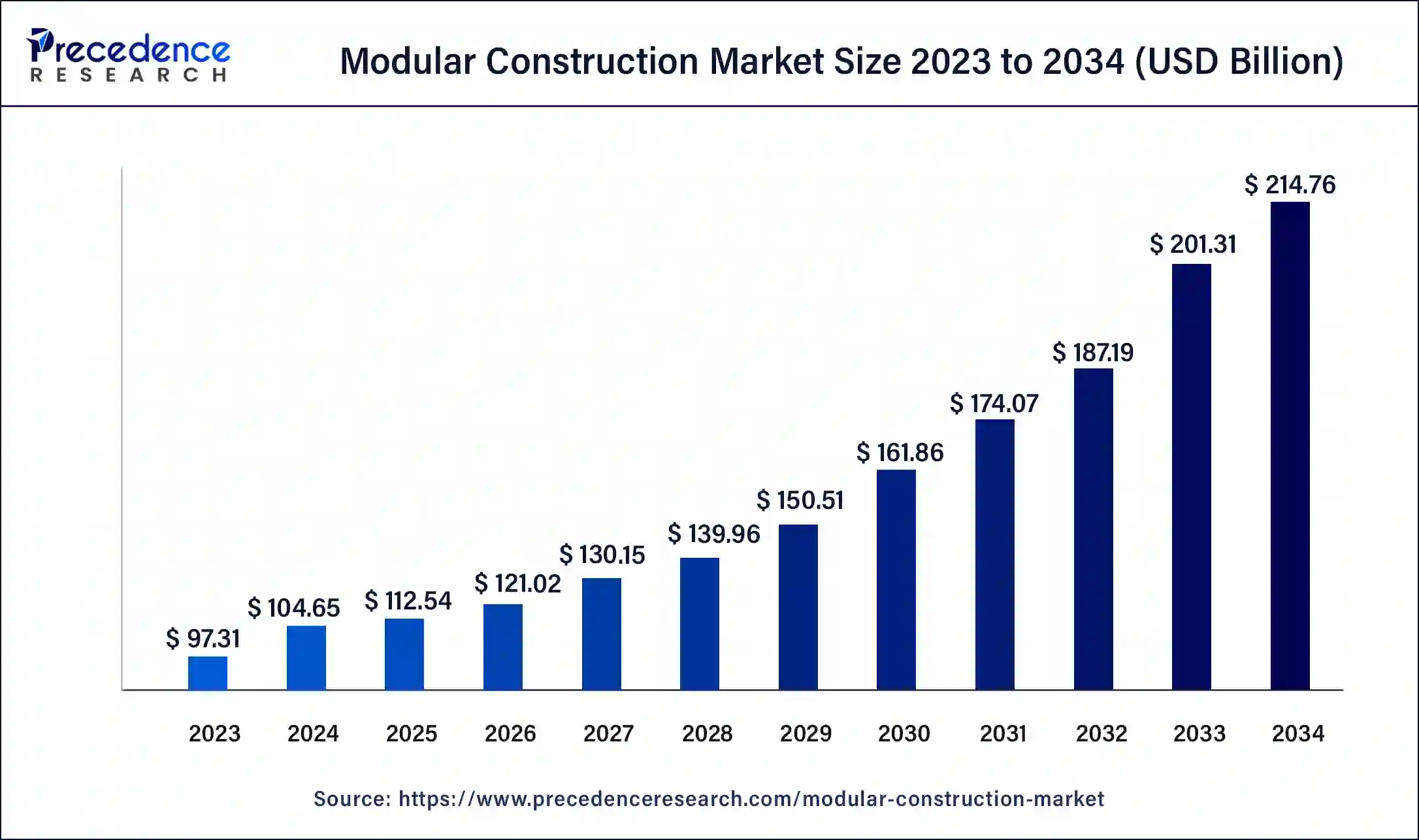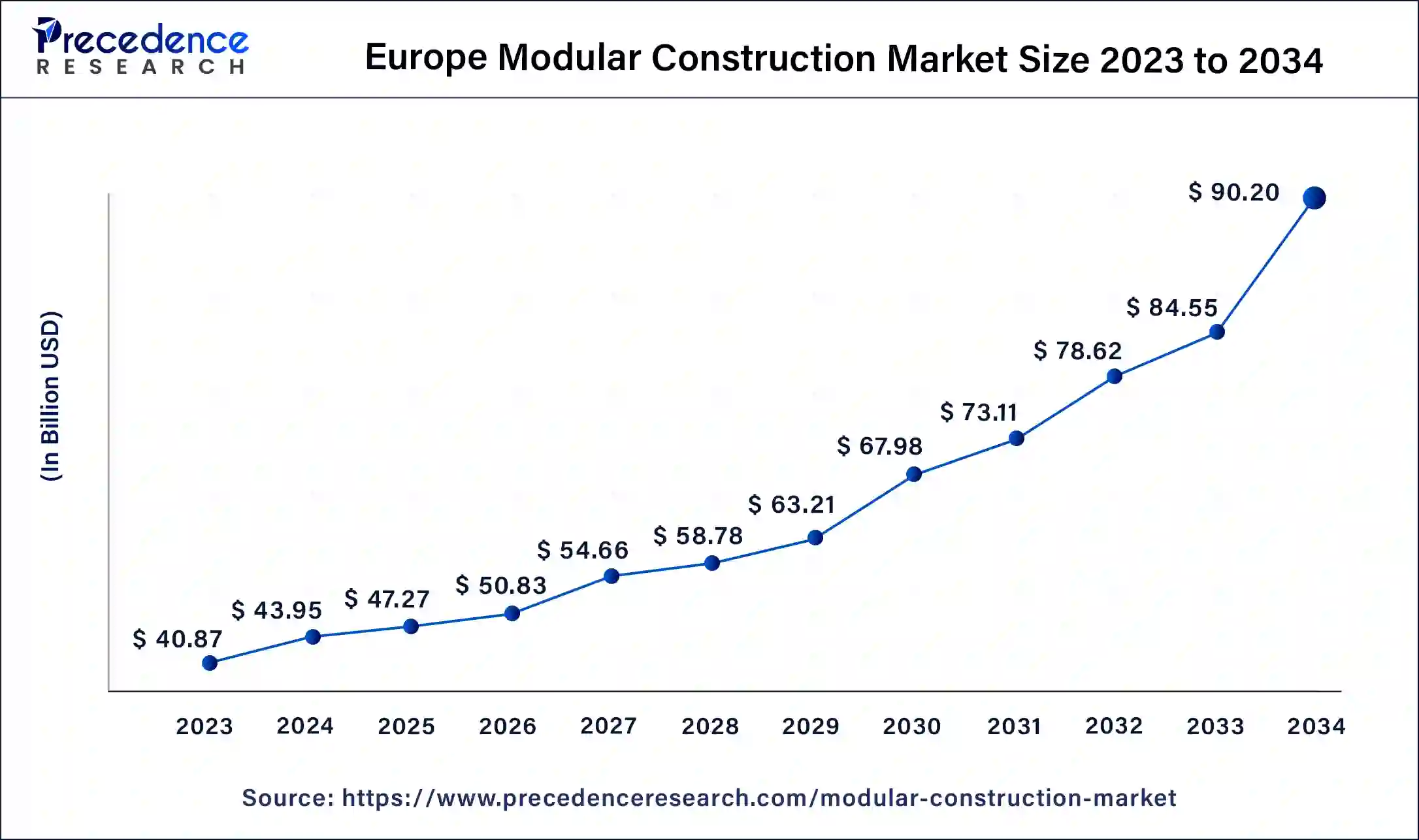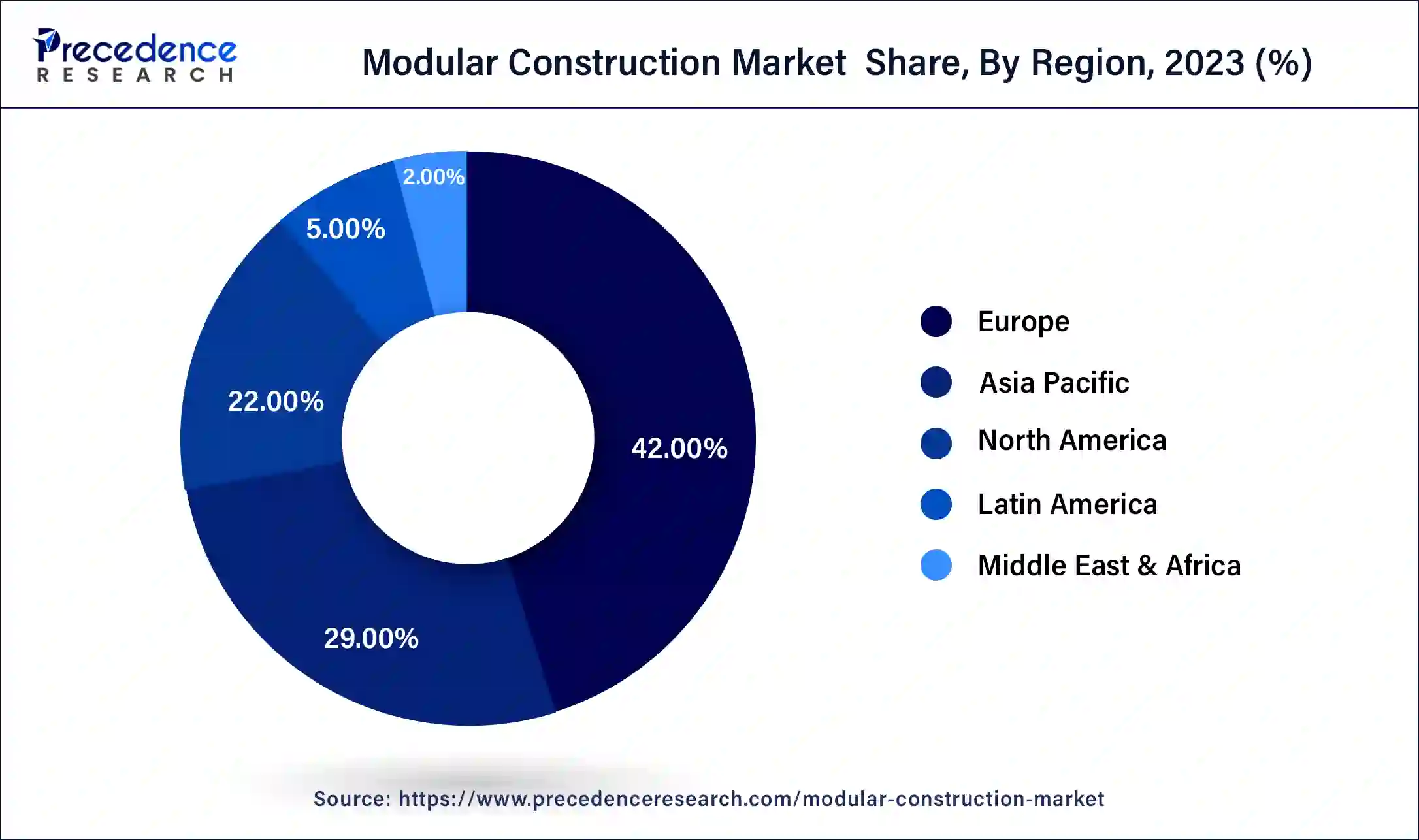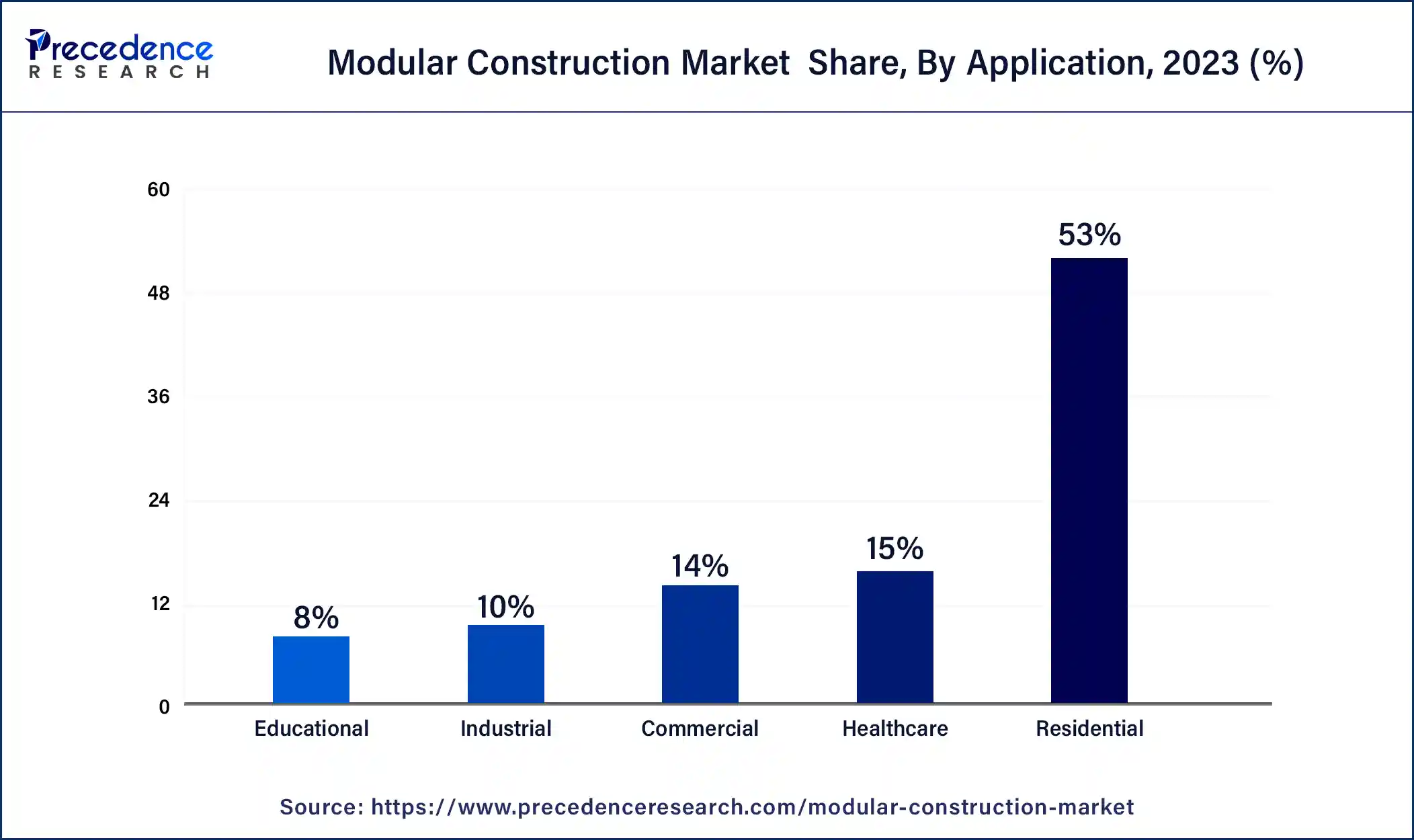Modular Construction Market Size and Forecast 2025 to 2034
The global modular construction market size was USD 104.65 billion in 2024, calculated at USD 112.54 billion in 2025 and is expected to reach around USD 214.76 billion by 2034, expanding at a CAGR of 7.45% from 2025 to 2034. This growth is linked to the growing demand for affordable housing coupled with the increasing investment in the development of healthcare and commercial infrastructure around the globe.

Modular Construction Market Key Takeaways
- In terms of revenue, the modular construction market is valued at USD 112.54 billion in 2025.
- It is projected to reach USD 214.76 billion by 2034.
- The modular construction market is expected to grow at a CAGR of 7.45% from 2025 to 2034.
- Europe led the market with the biggest market share of 42% in 2024.
- Asia Pacific is predicted to grow at the fastest CAGR of 8.33% over the forecast period.
- By product, the permanent modular construction segment has contributed more than 59% in 2024.
- By product, the relocatable product segment is expected to grow at a CAGR of 7% between 2025 and 2034.
- By material, in 2024, the steel segment has held the biggest market share of 42% in 2024.
- By material, the wood material segment is anticipated to grow at a notable CAGR 7.42% over the projected period.
- By application, the residential segment has accounted more than 53% of market share in 2024.
Europe Modular Construction Market Size and Growth 2025 to 2034
The Europe modular construction market size was estimated at USD 43.95 billion in 2024 and is projected to surpass around USD 90.20 billion by 2034 at a CAGR of 8% from 2025 to 2034.

Europe contributed more than 42% of the market share in 2024, largely due to high adoption rates in countries like Germany, Finland, the U.K., and Sweden. The main driving force behind this growth is the increasing influx of migrants, necessitating the development of both temporary and permanent housing structures. Furthermore, factors such as significant investments and the adoption of advanced technologies contribute to the expansion of the modular construction market in Europe. In the U.K., modular construction is gaining traction as an effective method for building affordable homes. This trend is driven by factors like population growth and housing shortages.

Asia Pacific is predicted to witness the fastest growth in the modular construction market, with a significant CAGR over the forecast period. This is linked to factors such as the expansion in the commercial and residential construction sector. Also, the increase in investments in the industry by market players, as well as government funding, drive the growth of the market in the region.
Market Overview
Modular construction involves creating prefabricated homes or structures using the same materials and design principles as traditional building methods. These structures are assembled using modules that are constructed off-site in a controlled environment. When all modules are combined, they match the exact design specifications required by building codes and standards. This method allows for efficient and consistent construction, ensuring that the final structure meets the same quality standards as those built on-site.
Modular structures can be easily taken apart, renovated, and moved for new modular homes, which reduces the need for raw materials and energy in building new structures. Modular construction, being controlled in factories, produces less waste and minimizes disruption on-site. With site work and modular building happening simultaneously, projects can be completed in half the time compared to traditional methods.
Modular Construction Market Growth Factors
- Increase in population and urbanization are driving the growth of the modular construction market.
- Rise in technological advancements in the construction industry coupled with innovations provided by modular construction can boost the market growth further.
- Growing efforts by the market players to adopt and use new technologies like 3D printing and building information modeling are likely to fuel the growth of the modular construction market.
- Encouraging government initiatives and increasing concerns for work zone safety contribute to market expansion.
- The industry is profiting from the growing trend towards sustainable construction methods and the rise in construction projects in developing countries.
MarketTrends
- The increasing global need for fast construction is spearheading industry growth in the current period. As the modular construction system is seen as a cost option for developers, which is expected to create significant opportunities in the coming period, as per the observation.
- The enlarged expansion of the healthcare and education sector has driven industry's potential in recent years. As these sectors allow faster setups, which is modular construction has gained significant attraction due to its speed in the past few years.
- The industry is observed as an increased adoption of sustainable practices nowadays. Also, the modular construction can create less waste than regular construction methods, which is heavily contributing to the industry's growth in recent years. Moreover, the rising need for energy-efficient buildings is gaining heavy attention in the current period as modular construction developers are leveraging this trend by providing better service nowadays.
Market Scope
| Report Coverage | Details |
| Global Market Size by 2034 | USD 214.76 Billion |
| Global Market Size in 2025 | USD 112.54Billion |
| Global Market Size in 2024 | USD 104.65 Billion |
| Growth Rate from 2025 to 2034 | CAGR of 7.45% |
| Largest Market | Europe |
| Base Year | 2024 |
| Forecast Period | 2025 to 2034 |
| Segments Covered | Product, Material, Application, and Region |
| Regions Covered | North America, Europe, Asia-Pacific, Latin America, and Middle East & Africa |
Market Dynamics
Drivers
Rise in urbanization and industrialization with an increase in the speed of construction and high efficiency
Modular construction, a modern method gaining popularity in building homes and businesses, is considered revolutionary. The increasing urbanization and industrialization have boosted economies, leading to a surge in demand for modular buildings. These structures are preferred because they are quicker to construct, resulting in lower overall costs.
With developing regions like Asia, Latin America, and Africa experiencing rapid population growth and urbanization, there's a significant rise in demand for housing, infrastructure, and social services. Modular construction allows designers to select parts based on effectiveness, saving time and money. Its efficiency and durability make it a preferred choice among professionals, which contributes to the growth of the modular construction market.
- A report published by Society Africa in May 2024 states that Africa drives global urbanization. Jean-Michel Bos. Although Africa's population is predominantly rural, the continent is now driving urbanization.
Restraint
Lack of reliability in earthquake-prone areas and lack of skilled labor
The modular construction market faces challenges related to earthquakes due to their lightweight module units and construction methods. Precast frame panels may not withstand strong earthquakes, and roofs and walls made of light materials like wood or metal can bend and deform. Consequently, modular construction is less prevalent in earthquake-prone areas.
Fear of technology and logistical issues also hinder market growth. Large projects like distribution centers may encounter difficulties with logistics, while smaller commercial projects in earthquake-prone areas find modular construction impractical and costly. These limitations pose significant barriers to the overall growth of the modular construction market.
Opportunities
The growth of the commercial sector
The market for modular construction is expanding as a result of the rising interest in this controlled environment alternative to on-site difficulties such severe weather. Similar to this, the market for modular construction is expanding due to the increased need for alternative construction systems brought about by the increase in construction expenses associated with green buildings.
Building operations in fields like hotels, offices, schools, etc. have increased as a result of the commercial sector's explosive growth, which has increased demand for this kind of building activity and fueled market expansion. Additionally, modular building is a popular option in contractual construction, which propels market growth, and is more favored for projects with stringent deadlines.
- The Central Bank of Singapore reports that the nation intends to invest more than USD 2.7 billion in housing and infrastructure projects. According to the government, by 2030, the public sector would issue green bonds worth up to SGD 35 billion, or roughly USD 25.3 billion, to fund environmentally friendly infrastructure projects.
Rise in demand for eco-friendly buildings
The modular construction market is fueled by the growing demand for environmentally friendly and energy-efficient buildings. Modular techniques allow for recycled and sustainable materials, reducing the environmental impact of construction. With greater awareness of environmental sustainability and the popularity of Green Building certifications like LEED and BREEAM, the modular construction market is predicted to grow rapidly. Additionally, the rising demand for high-strength materials such as high-strength steel, composites, and structural steel, known for their lightweight and strong properties, is expected to drive market growth.
Construction Type Insights
The permanent modular construction (PMC) segment accounted for the dominating share of 71.80% in 2024. Permanent modular construction is generally made of wood, steel, plastic, and concrete. These constructions are increasingly becoming a popular trend among consumers. Permanent modular construction (PMC) provides durable and long-term structures for various applications, such as schools, residential housing, and commercial buildings
Material Insights
The steel segment held a dominant presence in the market in 2024, with 42.50%. Steel is widely utilized in various forms, such as columns, I-beam shapes, angles, and T-shapes. This material possesses outstanding mechanical and chemical properties, including durability, high strength, ductility, seismic resistance, ease of fabrication, and fast erection speed. It is commonly used as a reinforcing material in concrete to offset its low tensile strength.
Product Insight
The permanent modular construction segment dominated the modular construction market in 2024. Permanent modular homes are made of wood, steel, and concrete. These houses are now becoming a popular trend among consumers because of their cost-effective, easy, and convenient features. Furthermore, modular houses are inexpensive and easy to put with one another and are available in different patterns and styles. Shipping containers are also being used by a lot of competitors and builders, which contributes to market growth.
In the modular construction market, the relocatable product segment is expected to grow at a significant rate for the forecast period. These structures can act as temporary housing for relief, and emergency operations have gained demand over the last decade. This building is made to be transported to various building sites. Such conveniences with regard to ease of construction and transportation make this segment popular among rescue and relief organizations.
Material Insight
The steel segment held a dominant presence in the market in 2024, with 42.50%. Steel is widely utilized in various forms, such as columns, I-beam shapes, angles, and T-shapes. This material possesses outstanding mechanical and chemical properties, including durability, high strength, ductility, seismic resistance, ease of fabrication, and fast erection speed. It is commonly used as a reinforcing material in concrete to offset its low tensile strength.
The wood material segment is anticipated to grow at a substantial rate in the modular construction market during the projected period. Due to its strong compressive strength and ability to bend, wood modular construction is gaining popularity in commercial buildings, single-family homes, and urban housing. The ease and speed of designing high-quality wood structures are significant factors driving market growth. Additionally, prefabricated wood products offer greater accuracy in size compared to materials like steel and concrete, contributing to the rapid growth of the market.
- In November 2024, Erik Brogan dives into the topic of innovation in construction and modern woodworking. As a seasoned contractor and business owner from Minnesota, Brogan recognizes that innovation is essential for driving the industry forward. In the article published by Downbeach, Brogan explores the complexities of modern woodworking techniques and technologies, highlighting advancements such as sustainable practices and cutting-edge materials.
Application Insight
The residential segment was credited for the largest share of the modular construction market. This is attributed to the focus on sustainability and aesthetics while constructing the buildings. It also includes single-family houses, rental housing properties, and multi-story buildings. The industry is seeing the rapid adoption of residential applications with reduced building costs and time.

Commercial modular construction has become increasingly popular in recent years, particularly in key markets like the U.K., the U.S., and Asia. The improving economic conditions in these regions are driving demand for commercial spaces such as offices, showrooms, and hotels, resulting in increased commercial building activities.
Module type Insights
The four-sided modules segment held the major market share of 36.40% in 2024, owing to their structural integrity and efficiency in the residential sectors. Four-sided modules are a preferred choice for building affordable and multi-story housing quickly. The segment is rapidly expanding and innovating through strategic moves and technology adoption. Such factors are likely to propel the segment's expansion during the forecast.
End-user sector Insights
The residential segment registered its dominance with 34.70% over the global modular construction market in 2024, owing to the rapid development in urban areas and the increasing demand for affordable and sustainable housing. The segment's growth is driven by the increasing focus on sustainability and aesthetics while constructing residential buildings. It also includes single-family houses, rental housing properties, and multi-story buildings. The industry is seeing the rapid adoption of residential applications with reduced building costs and time.
Service Stage Insights
The new construction segment contributed the biggest market share of 81.20% in 2024. The growth of the segment is driven by the rapid urbanization and increasing population growth, which spurs the demand for cost-effective, faster, and sustainable new construction, particularly in emerging economies. Moreover, supportive government policies and increased investment in infrastructure projects globally are expected to fuel the growth of the segment in the coming years.
Modular Construction Market Companies
- Sekisui House Ltd.
- LAING O'ROURKE
- Red Sea International
- Skanska
- Bouygues Construction
- Premier Modular Limited
- KLEUSBERG GmbH & Co KG
- DuBox
- Wernick Group
- CIMC Modular Building Systems Holdings Co., Ltd. (CIMC-MBS)
- Riko Hiše d.o.o
- Lendlease Corporation
- Modulaire Group
- Guerdon, LLC
- Hickory Group
Recent Developments
Cloud Apartment
Launch: In 2025, the cloud apartment introduced its latest innovation, CloudConnect. CloudConnect has the quick-connect MEP system, which is considered the newest launch in the industry, as the company claimed. According to the company's report, this system can reduce modular construction costs by up to 30%.
DuBox
Launch: In 2025, DuBox introduced its latest solution, productization. This solution can offer ready-made turnkey products to the consumer, as the company claims. Moreover, according to a report provided by the company, this latest innovation is likely to give products advantages while ensuring scalability, sustainability, quality, and speed.
Boldt
Company Establishment – In 2025, the Boldt unveiled their latest establishment of the company called Bildt. This launch is primarily focused on the modular construction activities. Also, the company can provide solutions to general contractors and architects for cost reduction and increasing the speed of construction, as per the company's claim.
- In May 2023, Guerdon, a modular construction company, revealed its acquisition of Champion Homes, another player in the modular construction industry, to expand its footprint in the residential housing market.
- In March 2023, XtreeE, a construction technology firm, disclosed its collaboration with New Living, a modular construction company, to co-create 3D-printed modular housing solutions.
- In January 2023, Boxabl, a modular construction company, declared securing $50 million in fresh funding to aid the advancement of its expandable modular homes.
- In December 2022, Balfour Beatty signed a memorandum of understanding with Holtec Britain and Hyundai Engineering and Construction (HDEC) to develop small modular nuclear reactors in the United Kingdom.
- In October 2022, Balfour Beatty announced that its 50:50 joint venture, Gammon, has been awarded an HKD 1.3 billion (USD 0.17 million) contract on behalf of Top Oasis Limited, a consortium formed by Sino Land Company Limited and CSI Properties Ltd to construct a residential development in Yau Tong, Hong Kong.
Segments Covered in the Report
By Construction Type
- Permanent Modular Construction (PMC)
- Relocatable Modular Construction
By Material
- Steel
- Wood
- Concrete (Precast Concrete)
- Plastic
- Others
By Module Type (or Structure System):
- Four-sided Modules (Volumetric)
- Open-sided Modules
- Partially Open-sided Modules
- Mixed Modules & Floor Cassettes
- Modules Supported by a Primary Structure
By End-User Sector/Application
- Residential
- Single-Family Housing
- Multi-Family Housing (apartments, condominiums)
- Affordable/Low-Income Housing
- Student Housing
- Commercial
- Offices
- Retail Spaces
- Hospitality (hotels, motels)
- Restaurants and Cafeterias
- Industrial
- Warehouses and Distribution Centers
- Power & Energy Facilities
- Manufacturing Plants
- Institutional
- Schools & Colleges
- Healthcare (clinics, hospitals)
- Government Buildings
- Defense & Military
- Infrastructure/Utilities
- Public Restrooms
- Toll Booths
- Utility Control Rooms
- Modular Bridges & Tunnels
By Service Stage
- New Construction
- After-sales Maintenance and Refurbishment (Renovation)
By Region
- North America
- Europe
- Asia-Pacific
- Latin America
- Middle East and Africa
For inquiries regarding discounts, bulk purchases, or customization requests, please contact us at sales@precedenceresearch.com
Frequently Asked Questions
Ask For Sample
No cookie-cutter, only authentic analysis – take the 1st step to become a Precedence Research client
 sales@precedenceresearch.com
sales@precedenceresearch.com
 +1 804-441-9344
+1 804-441-9344